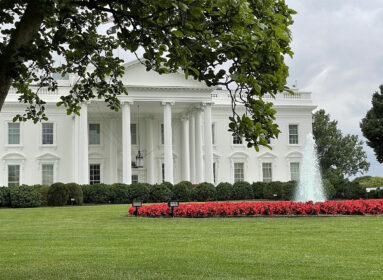 New exhibition digs deep into Judaism and the land
New exhibition digs deep into Judaism and the land
By Cindy Mindell
WEST HARTFORD – It would be difficult to pinpoint the most compelling aspect of “Return to the Land: Jewish Farming Around the World,” the current exhibition curated by the Maurice Greenberg Center for Judaic Studies at the University of Hartford.
The story of Jews working the land is ancient and modern all at once, and contains episodes from every part of the world where Jews wandered. It is a scholarly interest of both Richard Freund, director of the Greenberg Center, and Avinoam Patt, professor of modern Jewish history at the Center and director of the Museum of Jewish Civilization.
The idea for the exhibit coalesced from several sources, Patt says. Roberta Buland (see sidebar) and Bonnie Berkowitz, friends of the Greenberg Center, brought stories and photos from their years growing up on (Jewish) family farms in Connecticut.
Freund was planning a research trip to the defunct Jewish agricultural colonies in Argentina. Patt has researched and written about Jewish farming in post-Holocaust Germany, as well as the history of the Zionist and kibbutz movements.
In 2008, Patt was contacted by producers of the PBS documentary TV series, “History Detectives”, for help on a “mysterious” farmhouse in East Haddam with walls covered in Yiddish newspapers.
“All those incidents came together and we decided that it would be a wonderful story to tell, one that explored the story of Jewish farming around the world,” says Patt, who organized the exhibit and wrote the accompanying catalog. “It connects the Jewish farms in Connecticut with those in New Jersey, with the Baron de Hirsch-funded Jewish agricultural colonies in Argentina, and with the establishment of agricultural colonies and kibbutzim in Israel.”
Judaism began as an agrarian religion, born of and linked to the land of Israel that sustained the people. Prayers for dew and rain in their seasons; the harvest and pilgrimage holidays of Sukkot, Pesach, and Shavuot; the seven-year cycle of working and resting the soil – all this was lost during 2,000 years of exile and diaspora. In many countries, Jews were not allowed to work the land, let alone own property. The very shape of Judaism changed, with synagogues and prayer services replacing a central temple and celebrations of the earth’s bounty.
But then, in the 19th century, Jews began to return to the land – or, more specifically, were returned to the land.
 In 1854, American-Jewish philanthropist Judah Touro of Newport, R.I. died, leaving a bequest to help fund Jewish residential settlement in Palestine. British financier Sir Moses Montefiore was appointed executor of Touro’s will and used the funds for a variety of projects aimed at encouraging Jews to engage in productive labor.
In 1854, American-Jewish philanthropist Judah Touro of Newport, R.I. died, leaving a bequest to help fund Jewish residential settlement in Palestine. British financier Sir Moses Montefiore was appointed executor of Touro’s will and used the funds for a variety of projects aimed at encouraging Jews to engage in productive labor.
In 1855, he purchased an orchard on the outskirts of Jaffa that offered the first agricultural training to the Jews of the Ottoman Empire living in Palestine. He established the Yemin Moshe neighborhood outside the Old City walls of Jerusalem and included a windmill to produce cheap flour for poor Jews, as well as a printing press and textile factory, and helped to finance several early Zionist agricultural colonies.
This effort extended to North and South America as well. In the late 19th century, as persecuted Jews began pouring out of Eastern Europe, thousands were directed to northern Argentina, where the Jewish Colonization Association, in coordination with the Argentine government, was setting up farming communities.
German-Jewish philanthropist Baron Maurice de Hirsch founded the association in 1891 with $10 million, later adding $40 million more in assets to support an anticipated 3.5 million Jewish immigrants.
During the same period, the Jewish Agricultural Society in New York began a similar effort in Connecticut, establishing agricultural settlements in and around Colchester, Lebanon, and Montville.
Initiatives continued in Palestine. At the turn of the 20th century, the decade-long “Second Aliyah” wave of immigration brought some 30,000 Eastern European Jews to the Holy Land instead of the Golden Land of the U.S., driven by an idealistic, even “romantic-mystical” ideology, according to Patt.
“Zionists like A.D. Gordon believed that, to restore the Jewish people as a normal nation, they had to build a solid foundation of people who had connections to the land,” Patt says. “Living for 2,000 years in the diaspora, the Jewish people had been disconnected from their land and soil and had become ‘unhealthy.’ So by reconnecting to the physical land and establishing a connection to the soil, you created a connection to the ideological Land of Israel as well. Their motto was Anu banu Artza liv’not u’l’hibanot – ‘We’ve come to the Land to build and to be rebuilt’ – a simultaneous building-up of the land and rebuilding of the identity of the Jewish people through labor.”
 Many who arrived during the Second Aliyah, including future prime minister of Israel, David Ben-Gurion, were attracted by the appeal of chalutziut – the desire to become pioneers.
Many who arrived during the Second Aliyah, including future prime minister of Israel, David Ben-Gurion, were attracted by the appeal of chalutziut – the desire to become pioneers.
Kibbutzim flourished in the 1930s and 1940s. In 1922, there were 700 people living on kibbutzim. By 1927, the number had risen to 2,000. When World War II began in 1939, 24,105 people were living on 79 kibbutzim, comprising five percent of the Jewish population of Mandate Palestine. In 1950, the figures went up to 65,000, or 7.5 percent. The kibbutz movement peaked in the late ‘80s and then began to decline. Now, Patt says, many kibbutzim are enjoying a revival.
“What I found most interesting is that in many ways, Zionism, especially on the more secular kibbutzim, took the Jewish religious concept and appropriated it for the creation of a specific national identity and religion for the Jewish people,” he says. “They were restoring, on some level, the original concept of the pilgrimage and harvest holidays of Judaism, where offerings of first fruits were made at the Temple. Today, to be on a kibbutz for Shavuot is to see how you mark a biblical religious holiday in a modern form. Instead of prayer services, they have a festival of song and dance and the bringing of the first fruits, which is another way of marking the holiday in an authentic, organic, and natural way. It’s a beautiful representation of the Jewish return to the land and the original notion of Jews as an agrarian people.”
Perhaps the most audacious and profound use of farming as a Jewish statement is in post-Holocaust Germany, a topic Patt explores at length in his book, Finding Home and Homeland: Jewish Youth and Zionism in the Aftermath of the Holocaust (Wayne State University Press, 2009).
“Farming the estate of Nazi propagandist Julius Streicher or establishing the ‘Kibbutz Buchenwald’ agricultural training camp in Belgium was a symbolic revenge to appropriate Nazi land and turn it into their own,” Patt says.
The young Holocaust survivors who made up these post-war farms were not numerically significant, Patt says: compared to the 150,000 residents of Displaced Persons camps at any given time, only 3,500 to 4,000 youth inhabited 40 training farms.
“But the symbolism is tremendous,” he says. “It was a very important demonstration for the international observers from the American Jewish Joint Distribution Committee and the U.S. military of the survivors saying, ‘we are willing to take matters into our own hands, not be dependent but pull ourselves up and rebuild our own lives. They are also trying to prove to the Zionists in the Yishuv [pre-state Israel], that they would make productive and useful immigrants who would play an important role in building the country.”
Most of the Jewish agricultural colonies in the diaspora faded by the mid-20th century, as second or third generation inhabitants left for more opportunity in urban areas. Today, there is another revival of agrarian Judaism, exemplified in communities like the Isabella Freedman Jewish Retreat Center in Falls Village, Conn. and the Yiddish Farm in New Hampton, N.Y. And in Israel, applications to join kibbutzim outpace available housing.
Several public programs will complement the exhibition. The Greenberg Center is cosponsoring a series on the history of Jewish Hartford, together with the Jewish Historical Society of Greater Hartford. Later this month, Connecticut historian Mary Donohue will lecture on the history of Jewish farming in the state. In September, a panel discussion on Jewish farms past, present, and future will feature Donohue and Patt, along with representatives of the Adamah Jewish environmental program at the Isabella Freedman Retreat Center, and journalist-turned-farmer Ben Harris.
“Return to the Land: Jewish Farming Around the World” will be on exhigit through Oct. 1 at the, Museum of Jewish Civilization, Maurice Greenberg Center for Judaic Studies, University of Hartford, 200 Bloomfield Ave., West Hartford. For information visit uhaweb.hartford.edu/greenberg-center or call/ (860) 768-4964.
The Humpty Dumpty Farm in Chester
By Roberta Friend Buland
My paternal Jewish grandfather, Isaac (who had emigrated from Poland by way of England to the Lower East Side of New York City), legally changed his last name from Popowitz to Friend. Legend has it that it was the first thing he did upon arrival so that he could be known as an American, rather than a foreigner or “greenhorn.”
He bought a poultry farm in 1927 on Goose Hill Road in Chester and moved there with his family. On the street lived several Jewish farmers, some from the same part of New York City where he had lived. He named the farm, “The Humpty Dumpty Farm.” His sister and brother-in-law, Esther and Isaac Jacobson, had bought a neighboring farm a few years before on the same street. Other Jewish farms were owned by the Joseph Feldman family and the Harry Glazer family, making at least four Jewish farms within a half-mile of each other.
Isaac and Rachel Friend, along with their sons, Harry, Joseph (my father, born in 1913 in New York City), and Eugene worked the farm, raising mostly chickens and their eggs for sale. I remember my father packing up the rear of the Chevrolet coupe automobile with freshly killed and dressed chickens wrapped in brown paper to deliver to his customers from Chester to Old Saybrook. One of his customers was Chester Bowles, of Essex who later became governor of Connecticut. I often accompanied Dad.
At that time there was no real synagogue; rather, the Jews of Chester and Deep River gathered for Jewish holidays and some Shabbats at the Chester home of the Romanoffs, where I was named. In 1952, several Jewish families bought a church to convert to a synagogue.
In 1938, my father married my mother, Lillian Horowitz, who was born in New York City. In 1919, when she was six, her family moved to Moodus. By the time they married, my father was the sole owner of “The Humpty Dumpty Farm.” My mother was an integral part of the farm’s labor force who dressed and wrapped the chickens for sale every Thursday.
My father, although not a licensed Jewish ritual slaughterer, killed the chickens by slitting their throats, the same method used by kosher slaughterers, so that the chickens felt almost no pain. Killing in this way demonstrated respect for animals.
In 1946, Joseph closed down the farming business, but remained on the land, to pursue another business, selling frozen foods and ice cream to independent grocers in eastern Connecticut. He died in 1997. Lillian died in 2003, when the farm and the house were sold.
Roberta Friend Buland lives in West Hartford.
A new farmer learns to make his way
By Cindy Mindell
COVENTRY – West Hartford native Ben Harris left a full-time, international journalism career with the Jewish Telegraphic Agency (JTA) to return to Connecticut to learn how to farm. This year, he harvested for the first time at the organic Root Down Farm in Coventry, where his new community-supported agriculture project just sold out for the 2014 growing season.
Now 37, Harris traded in his press pass for flats of seedlings in 2010 to learn the ins and outs of farming. He first worked for a year at a small family-owned farm in Vermont, then earned a certificate in ecological horticulture from the University of California, Santa Cruz and spent a short stint on a farm in western Connecticut. He leased the two acres and greenhouse that comprise Root Down in February, and runs it together with one employee and volunteer help from his family.
This is Lesson One of farming, Harris says: “It is not a solo endeavor, but very much a collective, communal one.” Harris began to feel a pull toward the land about a decade ago, while living in Brooklyn. “I had a growing consciousness around food issues, which resulted in part from the Agriprocessors raid in 2008, in part from the circles I moved in in Brooklyn – personal friendships and the Park Slope Food Co-op scene,” he says. “Taken all together, there was a period of a year or two when the blinders came off and I appreciated it in a way I never had before; how colossally screwed up our process is in this country of bringing food from production to mouth. I was really inspired.”
But to go from inspiration to action is an uncharted process. “There was the whole question of, do I want to do this?” Harris says. “It’s one thing to be fired up about it and another to be down on my hands and knees to do this work. Will it be boring? So I did one year of farming to see, and it ended up being one of the best experiences of my life.”
Even though, as Harris was surprised to learn, the work is harder than it looks.
That’s Lesson Two: be protective of your body.
“It takes a toll, but it’s a glorious toll,” he says. “I love the feeling, at the end of the day, of being spent. I worked hard and accomplished something I can see and touch. That’s powerful to me.
Harris was raised in an Orthodox family and graduated from the Bess & Paul Sigel Hebrew Academy in Bloomfield. He keeps Shabbat, blogging about the specific challenges at the intersection of religious practice, thirsty plants, and market day. Does he consider himself a “Jewish farmer” or a “Jew who farms?”
“While I’m very close to my Jewish identity, I’m very much a Jew who farms and the connections between my religious life and my farming life are fairly insubstantial. Of course, I bring something of my Jewishness to every endeavor of my life, farming included. And I like the idea that Judaism has this vast body of law concerning agriculture and there’s a deep history of Jewish involvement in farming. But Judaism does not inform my farming in any meaningful way.”
That said, Harris finds farming to be a deeply spiritual endeavor. “The fact that tiny little seeds grow into fantastic plants with little more than sun and water never ceases to amaze me. The teeming life inside the soil that we can’t see and barely understand and yet depend on so completely – it just blows my mind.”
Harris’s JTA blog, “This Week in Jewish Farming,” is a chronicle of his professional transformation, peppered with thoughtful reflections, hard-won lessons, and practical tips of a committed and realistic environmentalist learning to live on and from the land.
For more information about Root Down Farm: rootdowncsa.com








 Southern New England Jewish Ledger
Southern New England Jewish Ledger











